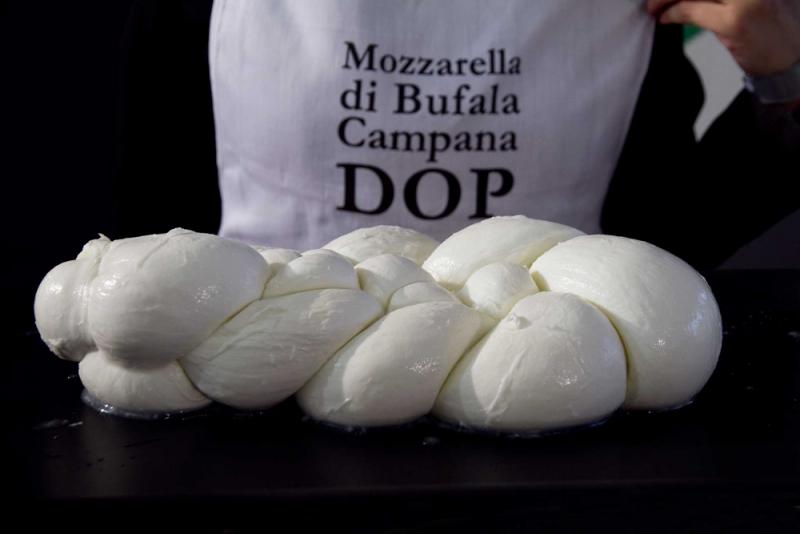Buffalo mozzarella from the region of Campania (Mozzarella di bufala campana) is one of Italy’s most prestigious and appreciated food products, used for the famous insalata caprese (Caprese salad), on pizza, calzone, on grilled bread, or simply by itself accompanied by olive oil.
However, as with many other Italian products, mozzarella di bufala campana is subject to counterfeiting. In addition, it suffered tremendously after the ‘Terra dei fuochi’ (Land of fires) scandal, which revealed that toxic waste had been illegally buried and burned for years in an area between the provinces of Naples and Caserta, polluting the land and the air, and causing serious health issues to the local population.
How is this related to mozzarella di bufala campana?
Because that is precisely the area that is the heart of buffalo mozzarella production. In order for buffalo mozzarella to be authentic, the milk and its processing must come from the following areas:
The entire provinces of Caserta and Salerno in Campania, and select areas within the provinces of Naples and Benevento, still in Campania; also, select locations in Puglia, Molise and Lazio.

[Bufala mediterranea italiana, or Italian Mediterranean buffalos.]
Only mozzarella that is made in these areas with the milk of Italian Mediterranean buffalos (Bufala Mediterranea Italiana, the only indigenous water buffalo breed in Italy), following the traditional techniques, can obtain the Mozzarella di Bufala Campana DOP trademark, the EU's Protected Designation of Origin system. This is important in order to guarantee the authenticity of the product.
The Consorzio Tutela Mozzarella di Bufala Campana ("Consortium for the Protection of the Buffalo Mozzarella of Campania") was established in 1981 to protect and promote a delicacy that is now synonymous with Campania cuisine and an industry that is worth approximately €300 million euros a year.
Here’s how you can recognize authentic mozzarella di bufala campana when you buy it at the store, according to the Consortium which has published guidelines on its website.
The package must indicate the following:
- full name of the denomination ‘Mozzarella di Bufala Campana’
- the logo must be present; under it, the national and EU data must be specified as follows: DPCM 10/5/93 for national legislation, EC Regulation No 1107/96 for EU legislation;
- the authorization number of the dairy factory must also be indicated, as follows: AUT. CONSORZIO TUTELA N. 000/00 / 0000.

This is especially important not only for the authenticity factor, but also for health reasons.
In 2008, traces of dioxin were found in samples of buffalo milk produced in Campania. The reason for it was attributed to the illegal practice of burning toxic garbage in the provinces of Caserta and Naples (later dubbed Terra dei fuochi) controlled by the Camorra, a mafia-type criminal organization, which even brought some countries to issue a temporary halt to the export of buffalo mozzarella. In 2013, declarations by a camorra pentito, Carmine Schiavone (originally made in 1997, but only declassified 16 years later), revealed the extent of these illegal practices, which justifiably led to a 30% decrease of Campania’s buffalo mozzarella sales volume.
Thus, in December 2013, the Consortium launched the so-called Operazione Trasparenza (Operation Transparency); 20 different mozzarella samples were examined by an independent agency in Germany deemed very reputable; it found that levels of dioxin and heavy metals in the examined samples were five times lower than the allowed maximum.
Mozzarella made by producers who are members of the Consortium continues to be constantly monitored. That’s why it’s important to look carefully at the label (the Consortium was not exempt from a scandal itself when one of its members was involved in an investigation that found that three local producers had used adulterated milk to make buffalo mozzarella).

[The traditional technique of 'mozzare', separating the curd by hand to form smaller balls.]
It certainly is quite sad that such a prized product with a long. esteemed tradition has undergone so much trouble in recent years. Mozzarella di bufala appears to have been made since at least the 12th century, when buffalos became increasingly valued for the production of their milk (how and when they were introduced to Italy isn't known for sure); the monks of the monastery of San Lorenzo in Capua, 25 km north of Naples in the province of Caserta, used to offer pilgrims a cheese they called mozza (or provatura when smoked).
In 1570, the term ‘mozzarella’ appeared for the first time, used in a text by Bartolomeo Scappi, the famous chef of the papal court. The term mozzarella derives from the procedure called 'mozzare,' which means 'cutting by hand', separating the curd to form small balls, a technique artisanal cheesemakers still follow.












